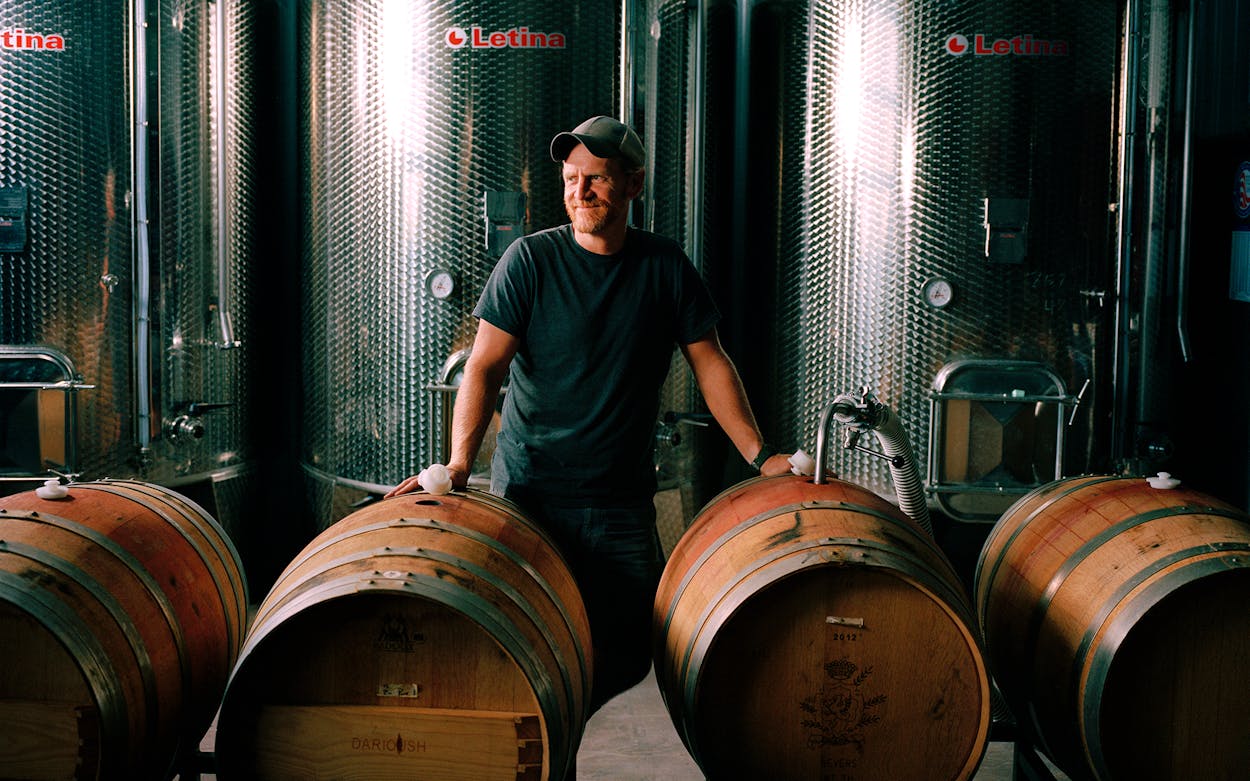In 2012 Regan Meador launched his Southold Farm + Cellar winery on Long Island, New York, swiftly garnering critical acclaim and a thirsty following across the country. But a few years later, faced with zoning conflicts that prevented him from expanding, the Eldorado, Texas, native and his wife and business partner, Carey, decided to relocate their whole operation (and their two kids) to a 62-acre property in Fredericksburg. It seemed like a natural move for the winemaker; during his many visits to see family in the Hill Country, he’d often drop in on wineries throughout the region, forging relationships with other vintners that would later serve him well as he adjusted to a drier, hotter climate.
The 39-year-old Meador is now helping to lead a new generation of Texas winemakers and setting the tone for the next chapter of the state’s wine journey. For many years, Texas has been known for big, opulent, heady wines. That’s partly because the growing season here begins as early as February, when buds begin to break on the vines, and extends into the still-sweltering days of fall. The longer that grapes ripen, the more sugars and flavor concentration they develop, which means more robust wines—and a higher percentage of alcohol. Often Texas producers push for this style, looking to mimic the brawny cult cabernets and rich zinfandels of California.
While there’s a time and place for these types of wines, not everyone wants to drink them, at least not all the time. This is why an increasing number of players in the state’s wine industry have started pushing for fresher, lighter, more balanced styles. And it seems to be working: for our fall wine guide online, Texas Monthly recently evaluated more than 180 new red and white wines from across the state, and the top 50 that we selected clearly indicate that we’re heading in this direction.


This isn’t an entirely new phenomenon. A handful of producers, including McPherson Cellars and Duchman Family Winery, have long championed more refreshing, youthful styles of wine. Now winemakers like Meador are experimenting with production processes. Rather than focusing on extra-ripe, concentrated fruit and heavy oak aging, as is common with richer, California-style wines, Meador uses a minimal approach, working to retain the acidity of the grapes to reveal the fresh vibrancy of the fruit. In Texas, that means harvesting earlier than when most producers do. He also uses native yeasts, rather than commercial strains, for fermentation and wields aging tools that don’t impart flavor, such as stainless steel, concrete, or neutral oak, to let the fruit express its own natural character.
“My first goal is to make delicious wine,” Meador says. “But I want to be transparent about my process and do as little as possible, to let the vineyard make the wine. Wine, at its pinnacle, is something that should capture a time and place. So for me to get in the way of that by pushing ripeness, acidifying, adding water, and further manipulating the wine . . . only obscures it.”
Terroir is also important to Meador, who’s moving toward using mostly Hill Country grapes after experimenting with High Plains fruit in the 2017 vintage. Although the Hill Country has more wineries than the High Plains area does, most Hill Country producers source at least some of their fruit from High Plains vineyards. “Working with the 2017 harvest as my first vintage of Texas wine convinced me that I really want to focus on the Hill Country,” Meador explains. “Not because the fruit from the High Plains isn’t excellent quality, but because Texas is only going to move forward as an industry if we nail down more regionality in our wines, like you see in other parts of the world. High Plains wines need to find their own identity, as do the wines of the Hill Country. We won’t find that if we are always blending them together.”
From the Texas Monthly wine tasting, it’s clear other producers are espousing similar terroir-focused approaches. The top fifty includes examples from Hill Country labels such as Calais Winery, Lewis Wines, and William Chris Vineyards. Newcomers Henry Crowson, of Johnson City’s Crowson Wines, and Adrienne Ballou, formerly of Lewis Wines and now with Calais, have both looked to Meador for guidance.
“We are so excited to see Meador come into the fold,” says Chris Brundrett, a co-founder of William Chris. “He’s producing unique wines that are made with intention . . . This will help push the bar forward for Texas wine.”
Trading power and intensity for finesse and lower alcohol content works well for food pairings. For example, among the white wines we tasted, the refreshing salinity of the light and elegant 2016 McPherson Cellars Marsanne makes it an ideal match for fresh seafood. Among the reds, the 2017 Southold Call of the Brave—a blend of cabernet franc and Sangiovese, with notes of herbes de Provence—complements barbecue without overpowering it.
“Southold’s wines are the type of juicy, refreshing, hard-to-stop-drinking wine with explosive aromatics that I usually look toward Beaujolais or the Loire Valley to find,” says restaurateur Steven Dilley, of Austin’s Bufalina, a recent Food & Wine sommelier of the year.
Meador is convinced that Texas has a ways to go before it can claim a mature, world-class wine industry. “We need to start ruling out certain varieties for each region,” he says. “That would be one more step in deciding what will define wine in Texas.”







